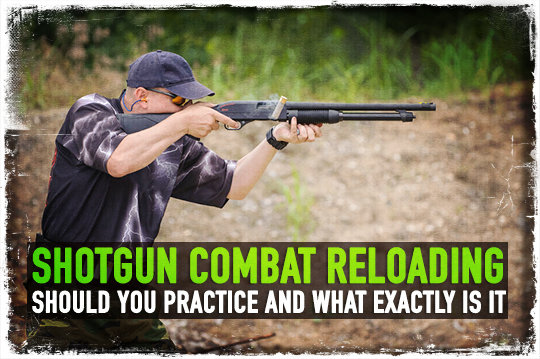
This article is focused on combat reloading a pump action or even a semi-automatic shotgun. As is in all cases it is up to the shooter to decide based on their comfort level and other considerations.
A shotgun combat reloading is sometimes called a tactical reload. However, some consider a combat reload as a top off while a tactical reload is reloading when your weapon has been fired empty. In years past the military, and most law enforcement agencies trained shooters to fire dry and then reload under cover or do a tactical reload while still maintaining target discipline.
In some cases, a tactical reload means discarding a partially full magazine for a full one to ensure the firearm is always fully loaded. One hand is ejecting the partially loaded magazine while the other reaches for a full magazine then slaps it into place. The muzzle is always pointed at the target during this process
A combat reload when it comes to shotguns usually means to load a shell as one is fired to maintain full capacity. This takes a conscious effort until it becomes a habit and once it does, you will find your hands are moving to perform the task even when your mind and eyes are engaged on the target, here is one example below.
Reloading under cover requires more moves on the part of the shooter and this can cause the shooter to lose sight of the target. However, dropping to one knee, with the muzzle down range while taking fire is unnerving to say the least, but if you have the proper training, you can reload by feel while still maintaining sights on target.
Today shooters are trained to top off and many call this a “combat reload”, fire one, reload one, fire two reload two and do all this by feel while maintaining a “sight on target position”. Pulling the weapon up to reload means you have to reposition when ready to fire, so it is important you can reload by feel only.
You always want your firearm to be at the ready to fire position at all times and an empty firearm is not ready obviously. A shotgun can only hold a few rounds, so in some instances you will have to reload in the middle of the action.
Typically, your shotgun fully loaded would get the job done, but multiple intruders may mean you have to reload to neutralize the threat. Even if all aggressors are down you still need to reload while maintaining eyes on the target (s).
Receiver mounted shell carriers are ideal for combat reloading, and some carriers allow you to carry shells with base up or base down depending on your personal preferences. If you are just starting to practice combat reloading, then try various methods of carrying your shells to find out which ways feels best for you. Some find it difficult to get used to receiver mounted shell carriers, while others do not like stock mounted shell carriers.
Keep in mind you may have to reach for shells carried in a pouch around your waist, so become familiar with all methods of carrying extra shells. Always keeping your receiver or stock mounted carrier fully loaded means you have shells available whenever you pick up your shotgun however. You may not have time to secure a pouch around your waist when you hear the front door crash in.
Use your hand as a cage so when you “pop” a shell from the carrier it is held securely in the palm of your hand. This position allows you to “slap” the shell in essentially. It will take practice to make sure you always have the shell positioned correctly in your hand for loading.
Knowing your shotgun is important, so before trying a combat reload make sure you are proficient with your firearm and always practice with training dummy rounds on an approved firing range set up for combat drills. You cannot become proficient without practice. Those that fail to practice will fire their weapons dry and then fumble for shells to reload. Seconds matter and not being able to reload quickly means you lose.